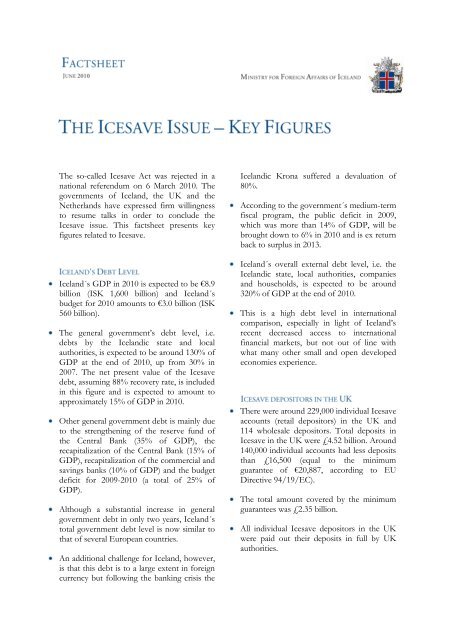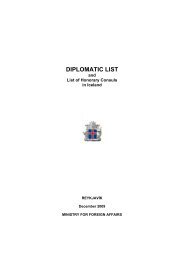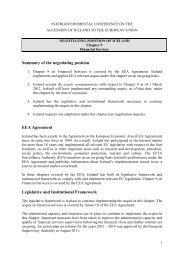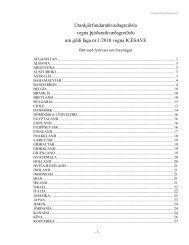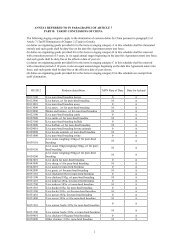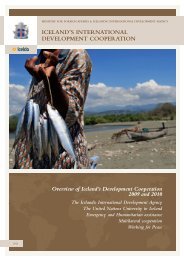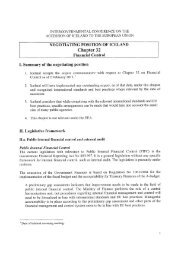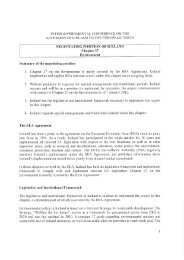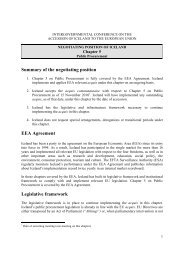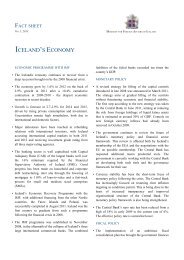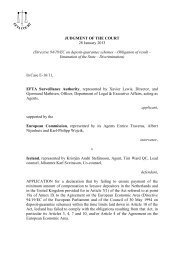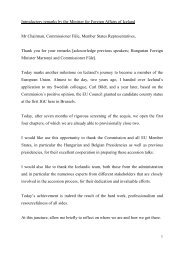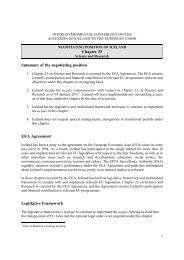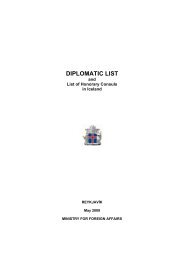Icesave Key Figures - Fact sheet
Icesave Key Figures - Fact sheet
Icesave Key Figures - Fact sheet
You also want an ePaper? Increase the reach of your titles
YUMPU automatically turns print PDFs into web optimized ePapers that Google loves.
The so-called <strong>Icesave</strong> Act was rejected in a<br />
national referendum on 6 March 2010. The<br />
governments of Iceland, the UK and the<br />
Netherlands have expressed firm willingness<br />
to resume talks in order to conclude the<br />
<strong>Icesave</strong> issue. This fact<strong>sheet</strong> presents key<br />
figures related to <strong>Icesave</strong>.<br />
Iceland´s GDP in 2010 is expected to be €8.9<br />
billion (ISK 1,600 billion) and Iceland´s<br />
budget for 2010 amounts to €3.0 billion (ISK<br />
560 billion).<br />
The general government’s debt level, i.e.<br />
debts by the Icelandic state and local<br />
authorities, is expected to be around 130% of<br />
GDP at the end of 2010, up from 30% in<br />
2007. The net present value of the <strong>Icesave</strong><br />
debt, assuming 88% recovery rate, is included<br />
in this figure and is expected to amount to<br />
approximately 15% of GDP in 2010.<br />
Other general government debt is mainly due<br />
to the strengthening of the reserve fund of<br />
the Central Bank (35% of GDP), the<br />
recapitalization of the Central Bank (15% of<br />
GDP), recapitalization of the commercial and<br />
savings banks (10% of GDP) and the budget<br />
deficit for 2009-2010 (a total of 25% of<br />
GDP).<br />
Although a substantial increase in general<br />
government debt in only two years, Iceland´s<br />
total government debt level is now similar to<br />
that of several European countries.<br />
An additional challenge for Iceland, however,<br />
is that this debt is to a large extent in foreign<br />
currency but following the banking crisis the<br />
Icelandic Krona suffered a devaluation of<br />
80%.<br />
According to the government´s medium-term<br />
fiscal program, the public deficit in 2009,<br />
which was more than 14% of GDP, will be<br />
brought down to 6% in 2010 and is ex return<br />
back to surplus in 2013.<br />
Iceland´s overall external debt level, i.e. the<br />
Icelandic state, local authorities, companies<br />
and households, is expected to be around<br />
320% of GDP at the end of 2010.<br />
This is a high debt level in international<br />
comparison, especially in light of Iceland’s<br />
recent decreased access to international<br />
financial markets, but not out of line with<br />
what many other small and open developed<br />
economies experience.<br />
There were around 229,000 individual <strong>Icesave</strong><br />
accounts (retail depositors) in the UK and<br />
114 wholesale depositors. Total deposits in<br />
<strong>Icesave</strong> in the UK were £4.52 billion. Around<br />
140,000 individual accounts had less deposits<br />
than £16,500 (equal to the minimum<br />
guarantee of €20,887, according to EU<br />
Directive 94/19/EC).<br />
The total amount covered by the minimum<br />
guarantees was £2.35 billion.<br />
All individual <strong>Icesave</strong> depositors in the UK<br />
were paid out their deposits in full by UK<br />
authorities.
In the Netherlands, there were 114,000<br />
individual <strong>Icesave</strong> accounts (retail depositors)<br />
and 28 wholesale depositors, amounting to a<br />
total of €1.67 billion. Around 90,000 of the<br />
accounts had less than €20,887.<br />
The amount covered by minimum guarantees<br />
was €1.33 billion. Dutch authorities decided<br />
to pay up to €100,000 for each <strong>Icesave</strong> retail<br />
depositor. There were 469 retail depositors<br />
that had more than €100,000 in their <strong>Icesave</strong><br />
accounts and the total amount not covered<br />
was around €40 million.<br />
On 19 November 2008, the IMF approved<br />
Iceland’s request for a Stand-by<br />
Arrangement.<br />
Loans related to the IMF program:<br />
• IMF: $2.1 billion.<br />
• Nordic countries: $2.5 billion.<br />
• Poland: $200 million.<br />
• The Faeroe Islands: $50 million.<br />
• Total funding: approximately $4.75 billion.<br />
The IMF completed the second review of<br />
Iceland’s economic performance under the<br />
program on 16 April 2010.<br />
Iceland, with a population of around 317,000, is a constitutional republic with a parliamentary government. Founded in 1944, Iceland<br />
joined the United Nations in 1946, became a founding member of the OECD in 1948, of NATO in 1949 and joined EFTA in<br />
1970. With Iceland´s accession to the European Economic Area in 1994, Iceland gained access to EU´s internal market. The<br />
foundations of the Icelandic economy, with a GDP of $11.4 billion (IMF 2009 est.) are fisheries, industry, tourism, pharmaceuticals<br />
and services.


